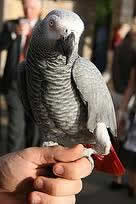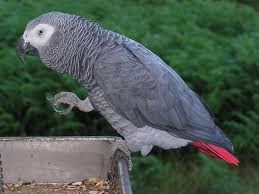
African Greys:
Home | |African greys | Amazons | Budgies | Conures | Eclectus | Helpful Links |

There are two subspecies of the African Grey: the Congo and the Timneh.
The Congo African Grey is the nominate subspecies, larger than the timneh. About 33cm (13in) long, grey feathers, cherry red tails, and all black beaks. These birds also initially have grey irises which change to a pale yellow colour as they get about a year old.
The Timneh African Grey is smaller in size have a darker charcoal grey colouring, a darker maroon tail, and a light, horn-coloured area to part the upper mandible. The timneh grey parrot is endemic to the western parts of moist Upper Guinea forests and bordering savannas of West Africa. As pets the Timnehs begins learning to speak earlier than Congos and are often said to be less nervous around strangers and novel situations.
In order to keep these parrots healthy a balanced diet is a must. Malnutrition can also lead to some of the following issues: poor health, hyperactivity, persistent screeching, bad temper, nonreplacement of feather after moult, biting, continuous moulting, and feather plucking. A good diet should be supplemented with a variety of fresh fruits and vegetables, along with grains and proteins, a small amount of seed mix can be fed to keep your African Grey parrot healthy and happy. Keep on mind that seed can be very fattening and are poorly balanced so they should not form a large part of the diet.
Choosing the right cage for your African Grey.
When choosing a cage you should consider the width between the bars, they should not be so wide that the parrot could get his head between the bars. Cages come in a variety of shapes, it is important not to choose a round cage as it has been known to cause psychological and orientation problems for African Grey Parrots.